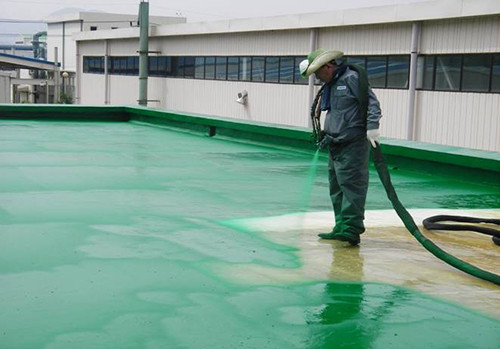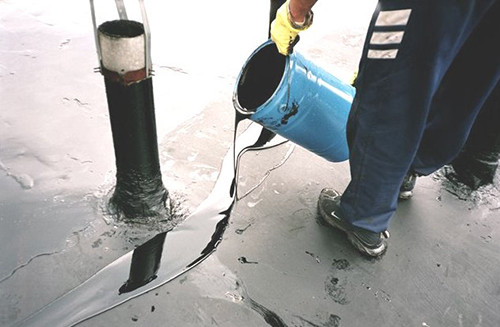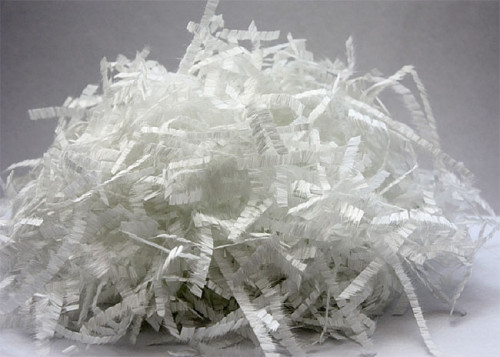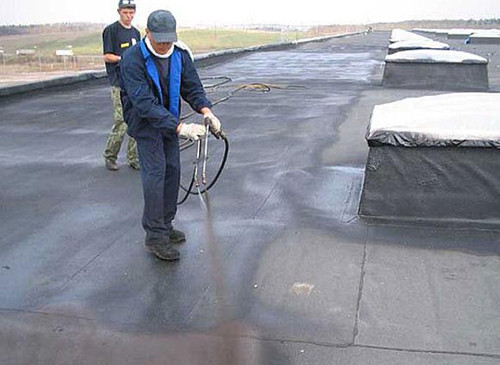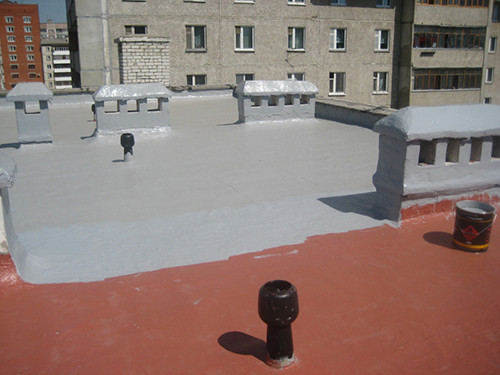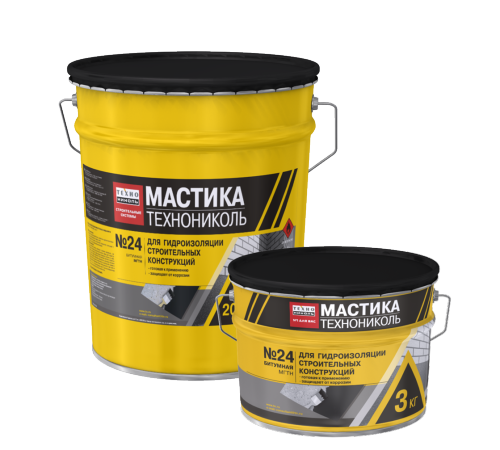Mastic roofs lately can be met more often on multi-storey residential and industrial buildings. This is a special kind of roofing, which is a viscous mastic (hence the name), frozen after applying to the surface and turning into a dense waterproof substance. Mastic roofs make up serious competition with rolled materials and other traditional coatings. On all the details related to mastic and the features of the device such a roof you will learn from this article.
Content
Features of the material
Under the concept of a fabric roof, various types of soft coatings are falling, having one common line - apply them in liquid form. Because the masts are cheaper than all other materials for creating a roof, and at the same time differ with decent quality, their popularity is fully justified.
The most important advantage of mastic roofs is that they are completely absent, which are known to be the most vulnerable areas and potential places of leakage. Thus, the waterproofing abilities of such a coating are much better than the rolled-in-film materials. To achieve such high-quality isolation, when installing, it is necessary to carefully monitor the thickness of the layers, which will be described below.
If the roof has a special bias, as well as in the processing of skates, endands, rash, and aircraft places with ventilation and chimney pipes, it may be necessary to further enhance.
There are several varieties of mastic roofs:
- reinforced;
- without reinforcement;
- mixed type.
Laying is carried out by special technology, which involves preliminary preparation of the surface, followed by the application of a hot or cold layer of material. After its drying, a dense hydrophobic film is formed.
Below on the video - the maintenance of the roof and the features of its laying:
Mastics as a material of many advantages capable of not only provide high operational performance of the roof, but also save time, money and strength on its arrangement. The cost of a mustache roof is significantly lower than any other modern materials with similar advantages. It is very popular regardless of the scale of work, whether it is a small garage or a roof of a huge warehouse. As a rule, the price depends on the manufacturer, composition and packaging of mastic.
Roofing device
Mastics can rightly be considered one of the best materials capable of providing high-quality protection of roofing pie from moisture, premature wear and mechanical damage. Often, mastic is not the main, but an auxiliary material used for local repair and protection of complex areas of the roof from wetting. Mastics repair membrane roofs.
Advantages of mastic for roof:
- high elasticity allows you to create an impenetrable film even on uneven surfaces;
- good waterproofing;
- protection against any kinds of precipitation;
- temperature resistance (capable of withstanding from -50c to + 100 ° C);
- high strength;
- durability;
- mounting allows you to reduce labor, temporary and financial costs to a minimum;
- can be used in private construction or for industrial facilities;
- solid coating without a single seam, which increases insulating abilities;
- it is possible to increase stiffness when using reinforced fiber.
However, there is one not that lack, but, rather, a specific requirement - mastic should be applied evenly with thin layers and achieve a homogeneous surface. Manually do it almost unreal, so builders use special technique. The exception is only such complex places like skates, adjoining, suspension and ribs, where you can simply pour the composition with a thick layer.
It is possible to work with mastic only in dry weather, after preparing the basis. It is applied by several layers, the number of which directly depends on the angle of inclination of the roof. So, if it is from 2.5 to 10 °, the waterproofing is needed good, because the water will not flock quickly. In this case, it will take 3 layers of mastic, 2 layers of reinforced fabric and gravel powder to protect the coating from ultraviolet. The roofs with a large slope of 10-15 ° can be covered with 2 layers of mastic, 2 reinforced canvases and a layer of weatherproof paint. If the roof inclination angle is 15-25 °, it will require 3 assistant, 2 reinforced layers and paintwork in the final.
Additional layers are relevant when working with suspensroles, skates, undershones, eaves and places of pipes. On the skate beams, mastic should be applied with a wide band no less than 50-60 cm, laying the reinforcing canvas from fiberglass or fiberglass. On cornices, rash and endows, it is necessary to organize a double layer with reinforcement. Where the roofing carpet is adjacent to the walls, as well as on vertical sites and any joints, two layers with gravel powder will be required, and the entirely recessed into another unknown mastic. A day later, aluminum paint is applied over such coating. At the end of each of the skates, mastic with a wide band of 50-60 cm with additional reinforcement should be applied. If there is a reset for water on the eaves, you need to close them with galvanized steel aprons.
Highlights of the device of a mustache roof:
- The base before applying must be projected 3-4 times.
- Each layer of mastic can be 0.7-1 mm, but not more.
- You can apply the next layer only after complete drying of the previous one.
Features of the installation of roof
As you already know, the mastic roofs are reinforced and unarmed. In the first case, fiberglass rolled materials are used, applying them using special equipment (fiberglass cut into small segments, mixed with mastic and span on the surface, resulting in a homogeneous mass).
The main complexity in the device of any kinds of mastic roofs is highly mechanized. In other words, manually without the technique there will be no longer anywhere. The choice of means of mechanization depends on the degree of complexity of the work and viscosity of the mastic composition. In any case, it must be applied by a very subtle layer, which is possible only when using special equipment and carefully prepared the base.
Mastic roofing technology technology:
- The first thing is to prepare the surface, checking the coverage of the coating with the help of levels and laying the reinforcing lining. The reinforcement is carried out by the fiberglass, which is interinted in bitumen mastic over the joints of the panels. Also for this purpose you can use flexible polyethylene compensators, laying them on a mastic layer.
- Vaporizolation of such a roof is made by compressor nozzle.
- The number of layers of mastic applied depends not only on the angle of inclination of the roof, but also from its functional purpose (operating mode).
- In places, the roof adjoins to the designs of vapor insulation are raised by one level with the insulation, but not less than 10 cm.
- In this case, the insulation and the screed are equipped in the same way as if they did a rolled roof. The only difference is that the heat-insulation is separated by wooden slats with templates, the heat insulation is divided into 20 mm deformation seams and a card screed with a size of 3x3 m.
- Unders, on the skate beams and cornices, the carpet must necessarily be strengthened, first putting compensating harnesses into the transverse seams and thoroughly wrapped the mastic. After that, flexible compensators are mounted, burning them into the cavity of the longitudinal seam and bending over the transverse. On top of the compensators are placed local reinforcing gaskets. As a binder, all the same mastic is used in all cases.
- Printing the surface of the roof is also necessary using a technique with a thin uniform layer with a thickness of 1 mm.
- Mastics are applied immediately after drying the primer, because if you withstand too much pause, the surface will clog, and it will have to be cleaned.
- Starting mastic should be started with the most distant raising materials on the roof of places. First handle the lowest points, gradually reaching the highest.
- If there are lights on the roof, starting the installation is recommended from them.
- When all the layers of mastic are applied, and the latter has not yet managed to dry, a gravel crumb is poured on it or coarse sand to protect against ultraviolet radiation. Also for this purpose can be used aluminum paint.
- If the roofing pie involves the presence of a ventilated layer of fiberglass with lumens and powder, on the surface it creates a kind of drainage. It contributes to the speedy evaporation of moisture both from the surface itself and from the insulation.
- If the roof base is made of wood, it is pre-laying the waterproofing with the upper layer of cardboard with water-repellent impregnation and gravel powder.
Reviews of mastic roofing more than encouraging. With competent installation, their service life is 25-30 years without the need for overhaul. If you fulfill all the requirements for operation and care, viewing the roof for leakage and eliminate them in time, the coating will last for a very long time. To do this, only once every 1-2 years pay attention to the careful inspection.
Features of the mastic roofing technonikol
TechnoNikol is the largest manufacturer of building materials for various purposes presented in the domestic market. Roofing products are particularly popular because they are distinguished by high quality and acceptable cost. We suggest to consider TECHNONIC MASTERNIKOL materials used for local and overhaul roofs, as well as creating absolutely new coatings and high-quality waterproofing.
TechnoNIKOL is characterized by a wide range of proposed mastic compositions for the roofing device:
- "Eureka" №41 - this mastic can be used both in cold and hot. It is used to create a durable waterproofing layer, repair of an old roof or new installation. In general, the universal composition for all occasions.
- "Technomast" №21 - a ready-made mastic composition, which is based on bitumen and rubber. Various additives and fillers give the material greater elasticity and increase operational characteristics. The coating made by the mastic "technomaist" is distinguished by increased heat resistance, hydrophobicity and elasticity.
- №31 - MASTAKE TECHNONIKOL universal purpose, intended for repairing damaged coatings, creating a waterproofing layer and creating a new roof.
- №33 - mastic, distinguished by water-emulsion nature. It does not have a drop of solvent, which makes it possible to significantly reduce the timing of roofing works. Mastica №33 is actively used for the roofing devices of any type, as well as to protect insulation in roofing pies from moisture penetration.
- Aquamast - bitumen mastic on a rubber basis. It is distinguished by the fact that it is applied in cold form. The composition in addition to the oil bitumen and crushed rubber includes various fillers, additives and solvents. The material is used to repair a damaged roof and mounting new. After applying, mastic dries and forms a high-strength coating capable of withstanding extreme temperature differences. Can be used in any climatic zones.
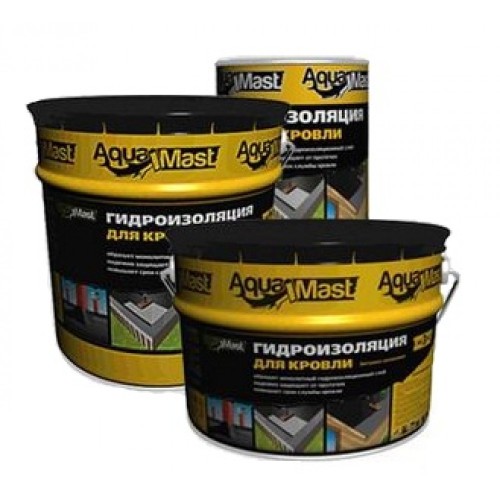
The cost of shale roof on a mastery depends on the selected composition. Its, in turn, should be selected in accordance with the required operational characteristics of the roof - in which climatic zone the building is located whether any equipment is installed on the roof, what is its area, etc. However, in any case, the price of a mustache roof, even taking into account the use of special equipment for applying composition, will be lower than many modern materials of similar purpose.



